Ocean microbes reveal distribution of nitrogen-fixers at a global level

Nitrogen is one of the major building blocks of life. It makes up 80 percent of Earth's atmosphere and it is described as one of the most important growth-limiting nutrients for both land and marine plants. This is because the most abundant form of nitrogen—dinitrogen, or N2—is particularly stable and resistant to chemical reactions, meaning that it cannot be assimilated by most organisms. Given the important role nitrogen plays in all living matter, microbes that can 'fix' atmospheric N2 into more accessible forms for organisms are crucial components of Earth's ecosystems.
Understanding marine nitrogen fixation provides key insights
Nitrogen fixers, also known as diazotrophs, are nature's fertilizers. On land, more than 90 percent of nitrogen fixation is performed by bacteria living in symbiosis with a diverse group of plants. These systems have been studied in detail, in part because the process is crucial to modern agriculture. But there is at least as much nitrogen fixation occurring in the ocean as on land—and this is much less well understood. Nitrogen is a key driver of plankton dynamics, and therefore of global biogeochemical cycles and climate. By building a clearer picture of nitrogen fixers in the ocean, scientists can obtain valuable information relating to ecosystems experiencing anthropogenic change.
Marine nitrogen fixers come in very different shapes and sizes, and that can make them difficult to collect and study. There is also a more obvious challenge: the vastness of the ocean! "This is where the Tara Ocean Foundation and related projects, based on sampling of marine plankton communities throughout the world's ocean at an unprecedented scale, comes into the story," notes Chris Bowler, CNRS scientist at the Institut de Biologie de I'École Normale Supérieure (IBENS) in Paris, and co-author of a new paper that highlights the work of an international research collaboration on this topic.
Sampling and analysis on a vast scale
In their study, published in Nature Communications, the researchers looked at the global distribution of marine nitrogen fixers. Working from more than 2 million images, generated by the Tara Oceans expedition from 2009 to 2013, the teams greatly added to knowledge about the abundance, diversity, and distribution of nitrogen fixers in the ocean. The research schooner, Tara, sailed 140,000 km over a period of 38 months across the main oceanic regions. During this time the scientists aboard systematically collected plankton samples of all sizes, as well as corresponding data on the environment these were found in.
Using the data collected, the researchers employed machine learning prediction tools to analyze over two million images in combination with DNA sequencing data. Co-author Eric Pelletier from French National Sequencing Centre, CEA/Genoscope, comments, "it is one of the very first large scale high-throughput analyses where omics—namely genome information—and imaging data—revealing the shape and size—of microbial organisms in the wild were connected, opening a new era in environmental studies."
This paper demonstrates the power of collaborative research, as well as underlining the scale that can be covered using the latest approaches. EMBL's Advanced Light Microscopy Facility played a central role in the project. Co-author and EMBL Director of Scientific Core Facilities and Scientific Services, Rainer Pepperkok, underlined the important role that the facility will play in future studies, "The high-throughput, high resolution, 3D light microscopy technology developed in collaboration with the ALMF and scientists from the TARA oceans consortium was central to this piece of work. It was the prerequisite that enabled the acquisition of millions of high resolution images of marine samples—representing an incredibly valuable resource—which was followed by the comprehensive analyses as documented in this paper. There are a number of ways in which we are further developing this approach, allowing for even greater analysis in future studies."
Rachel Foster from Stockholm University, co-lead author of the study, adds, "I was initially surprised by how well the images predict the genes and the genes predict images. Plankton is naturally patchy and sampling the 'patches' is difficult. The high-throughput imaging datasets were essential in our work. We gained important insight into the ecology of these biogeochemically relevant populations."
Understanding anthropogenic changes
In addition to contributing to a far fuller picture that previously existed, the research detected new abundant 'hotspots' in understudied oceanic regions, where multiple nitrogen-fixers appear to co-occur. Lead author Juan Pierella Karlusich of the French Institut de Biologie de l'Ecole normale supérieure (IBENS) comments: "These results will advance the research field by bringing attention to these new high-density regions and the new types of nitrogen-fixers. For example, we were very surprised to discover ultrasmall but abundant bacteria that appear able to fix nitrogen, as well as other symbiotic associations only found previously in freshwater environments."
As well as offering an insight into the distribution of nitrogen-fixers at a global level, this work also provides a proof of concept that integrative analyses of molecular and imaging data can lead to more accurate explorations of ocean microbes. Such explorations provide valuable information relating to factors such as climate, and how ecosystems are being affected by the impact of human activity.
More information: Juan José Pierella Karlusich et al, Global distribution patterns of marine nitrogen-fixers by imaging and molecular methods, Nature Communications (2021). DOI: 10.1038/s41467-021-24299-y
Journal information: Nature Communications
Provided by European Molecular Biology Laboratory





















